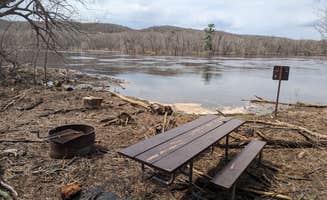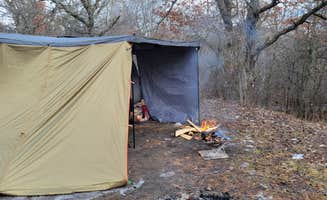Dispersed camping areas near North St. Paul, Minnesota offer primitive outdoor experiences within a 90-minute drive from the Twin Cities. South of Sand Dunes State Forest features sandy terrain interspersed with pine stands, while riverside camping can be found along the St. Croix National Scenic Riverway. These rustic options typically require campers to be self-sufficient, bringing their own water and supplies. The region experiences seasonal limitations with spring flooding along riverfront sites and heavy mosquito activity during summer months, particularly in June and July.
What to do
Explore wooded trails: The network of paths around South of Sand Dunes State Forest provides hiking opportunities through varied terrain. "I love that it's so close to home. I was able to walk in and find an incredible spot to camp and lay in my hammock," notes Joslyn H., highlighting the accessibility for day activities.
Paddling access: The St. Croix River offers kayaking and canoeing opportunities with multiple put-in locations. Visitors appreciate riverfront camping spots that allow direct water access. "The crushed gravel path to the south makes travel to the nearby Lions park easy," Travis B. mentions about riverside access points.
Wildlife observation: Various bird species can be spotted throughout these camping areas, creating natural opportunities for birdwatching. "Quiet with lots of different bird sounds," Jason B. commented about his experience, indicating the diverse avian population in these rustic camping areas near North St. Paul, Minnesota.
What campers like
Privacy and seclusion: Despite proximity to urban areas, many sites offer peaceful camping experiences. Samuel C. noted, "For the proximity to the city and nearby highways, this was a good spot. Didn't expect to see as many campers as I did, but all seemed to be friendly."
Extended stay options: Sandy Cove on the St. Croix River and other dispersed areas allow longer camping periods than many managed campgrounds. The remote nature provides a true disconnect experience for those seeking to avoid crowds.
Accessibility without amenities: Many campers appreciate the balance of reasonable road access while maintaining a rustic experience. Adam W. remarked, "I just did an overnight camp one night in a truck camper and it was very easy to navigate and it was cleaned quiet area to spend the night."
What you should know
Road conditions vary: Access roads range from well-maintained gravel to challenging dirt tracks depending on location and recent weather. "The road goes for a long ways, I parked near the front and closer to numbers, always like to be safer," advises Samuel C., suggesting newcomers stay near main access points.
Traffic considerations: Some forest roads experience unexpected traffic. Ryan P. cautions, "This road is pretty busy for a dirt forest road and people FLY down it. Almost got hit a few times walking. Even through a Wednesday night cars are flying down the road."
Wildlife encounters: Beyond birds, larger wildlife presence requires proper food storage and awareness. "Stand storks are very protective. Stay away from them. They attack," warns Heather W. about one particular species found in County Road O Landing.
Tips for camping with families
Location selection: Choose spots closer to main access roads for convenience with children. Skip H. recommends specific areas noting, "Great spot. Plenty of parking. Best for straight vehicles or very small trailers."
Bug preparation: Insect activity can significantly impact family camping experiences, especially in early summer. "We camped here on our way to the badlands. It was easy to find, and the spot itself was good and had restrooms. The only problem was the mosquitoes," cautions Marie G.
Day trip options: Plan day excursions to nearby developed recreation areas when primitive camping becomes challenging. Jennifer H. suggests, "We arrived in the late afternoon and drove all the way down the road, there are a few spots near the boat ramp and bathroom, but we parked near the trailhead and it was perfect!"
Tips from RVers
Size limitations: Most dispersed camping areas accommodate smaller campers but pose challenges for larger rigs. Gregory notes, "Drove past several sites, most of which were by water. We did find one we thought we liked, but branches over hung, and rested on our camper (8ft high) and in fact most sites were shaded."
Parking strategies: Many sites require creative parking approaches for vehicles with trailers. "I really recommend this for an easy stop if you're looking for a place to put up. It's peaceful and tons of spots to park," suggests Skip H. about finding appropriate spots.
Overnight considerations: Some areas work better for quick stays rather than extended camping. Aly E. shared her experience: "I pulled into the campsite late at night and was really confused where to go. There are bathrooms and 1 bar of Verizon. We ended up staying in the parking lot near the boat ramp and woke up to amazing bird calls."



